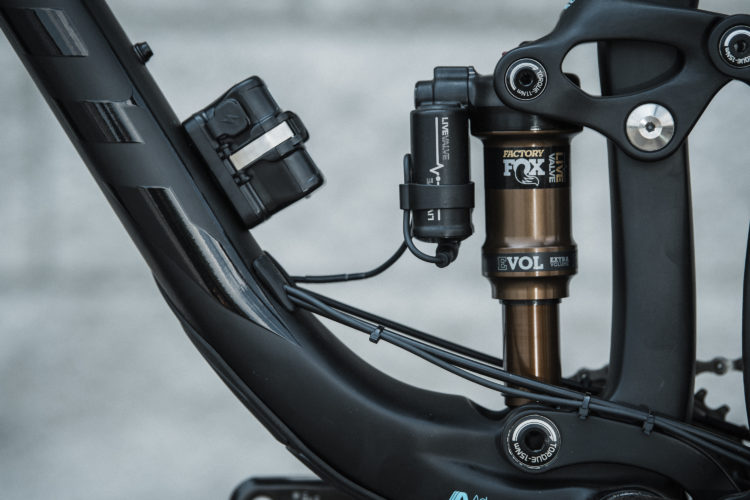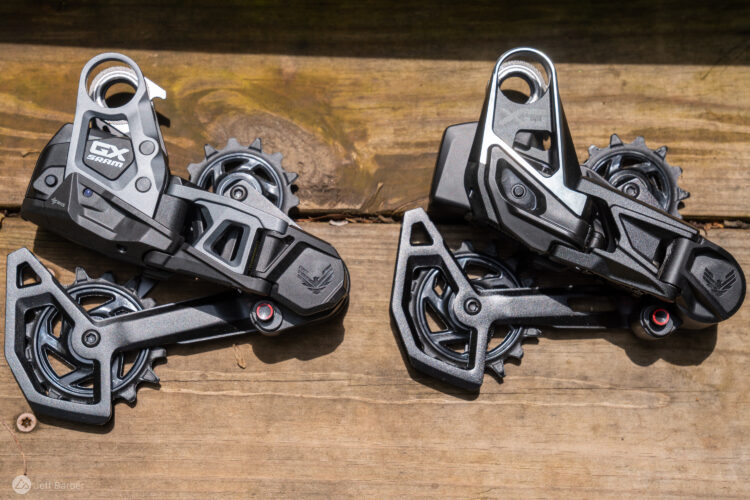
If I had to describe myself, I’d say that I’m a purist. I usually shy away from gimmicks and nonsensical inventions that offer nothing revolutionary, like plus-sized tires for example. I consider myself a slow-to-warm-up mountain bike rider, usually watching from the sidelines to see how things pan out.
In the same breath, I’ve always admired new tech and have welcomed advancements that have made the user experience better/faster/easier. I rode high-pivot mountain bikes 20 years before they were in vogue. All my mountain bikes were modified into one-by drivetrains with chainguides, going back to the 90s. I jumped into the tubeless game before aftermarket companies started making them.
When I found out I had the opportunity to try out the Rock Shox Flight Attendant electronic suspension system, I had some mixed feelings. On the one hand, I was a bit apprehensive. Do I want batteries on my mountain bike? Hard no. Will it make my riding experience more enjoyable? Doubtful.
On the other hand, I was excited to tickle my techno-cravings and try this new electronic gadget. My previous experience with electronic suspension isn’t something worth bragging about. It goes back to that one time in the 90s when I tried K2’s piezoelectric suspension. While that experience wasn’t favorable, I did remain open-minded enough to give this test a fair shake. For someone who has been deep into this industry going on 30 years, I could say that I’m coming into this review with a fresh set of jaded eyes.


Flight Attendant pricing
Let’s get the awkward bit out of the way first. While Flight Attendant is available on a select few complete bikes, SRAM offers complete kits to electrify your ride. Kits include the fork, shock, shock hardware, pedal sensor, two batteries and a charger.
- Trail (Pike): $2,799
- All Mountain (Lyric): $2,849
- Enduro (Zeb): $2,899
My test mule was a completely stock 2023 Norco Sight C1 with Flight Attendant, so the setup phase was already partially completed for me. This bike features the All Mountain kit which includes a 160mm travel Rock Shox Lyric fork.
Flight Attendant setup
Since the bike is a Norco, I started by going onto their website and using their patented Ride Aligned setup guide. I entered my height, weight, and rider skill level, which resulted in very solid recommendations for suspension settings, bar width, etc. The tool is quite slick and astonishingly accurate. Regardless of which brand of bike you have, you’ll need to set it up first.
Next, I downloaded the SRAM AXS App in order to access all the features and controls that can help with fine-tuning the suspension settings. The app is used to calibrate the Flight Attendant system and pair the pedal sensor with the fork and shock. Detailed instructions can be found in this video or in the Rock Shox Flight Attendant user manual. Don’t be afraid, as it’s a very quick and easy process to follow.
The settings can be adjusted to have a bias toward pedaling efficiency or by allowing the suspension to remain in the open setting more often. You can also adjust low-speed compression through the Flight Attendant Control Module or by way of the AXS App. I purposely left it in the neutral position during my test period but will experiment with bias settings in a longer-term review. I’d recommend that you do the same and get some miles on the stock settings before fine-tuning the bias parameters.

On the trail with the Rockshox Flight Attendant
I mostly rode my Flight Attendant-equipped Norco Sight C1 on the North Shore mountains of Vancouver, along with a couple of trips to the Interior region of British Columbia and Leavenworth in Washington State. The North Shore riding consisted of long climbs and steep, root- and rock-laden descents. There are a lot of trails to pack into your average North Shore ride, more so than almost anywhere. The riding in both the interior of BC and Leavenworth is fast and smooth in comparison and made for a great juxtaposition to the jank of the North Shore. I even threw in a gravel ride and a paved climb to dive deep into the merits of electronic suspension.
Manual Mode
During my first few rides aboard Flight Attendant, I purposely left it in manual mode so I could suss out what each setting was doing. And, it was my attempt at showing that tiny computer who’s the boss. I was convinced that I would find faults in the system. More on that later.
Flight Attendant’s prominent main feature is the ability to assist in climbing. When I was pedaling in manual mode, I’d reach down and press the pedal and lock functions on the top of the fork module. The ease of using the optional AXS handlebar-mounted controller would have been welcomed, although it wasn’t a deal breaker.
Pressing ‘lock’ makes the bike feel like a hundred-meter sprinter waiting for the start gun. The front and rear firm up and go into attack mode. Although the Norco Sight C1 is a 150mm rear/160mm front travel bike, having Flight Attendant allowed it to take on a trail bike stance (in a good way). The Norco is already an efficient climber, and Flight Attendant just amplifies this trait. I soon discovered that Pedal mode was a happy medium if technical climbing was on the menu. I have to admit, the whole bike firming up on a climb is a nice feeling.
Switching to open mode is party time, as the suspension’s damping circuits release, allowing the bike to use its full potential on the descents.
Auto Mode
Okay, this surprised me. I expected that I would run into situations where Flight Attendant wouldn’t be able to keep up with changing trail conditions or be caught off guard. I expected to switch back to manual override because there was no way that this little computer was more intelligent than me.
During the whole testing period using the auto mode, Flight Attendant never once faltered, never made any real poor decisions and read the terrain nearly perfectly. Lord knows I tried to upset it. Where I would have intentionally pressed the Pedal or Lock modes, it would almost always do it automatically and accurately. As soon as the bike is pointed downhill, the whole system opens up and stays open. I purposely rode very technical terrain, filled with abrupt elevation changes and sharp impacts. I wanted to confuse it outright, but for almost every mode change I would have made, Flight Attendant did it for me. The system never once made any huge errors in judgment on any type of trail, steep chute, or drop-off that I rode. That’s very impressive.
If I were to nitpick, I would say that on certain fire road climbs, the system can exhibit some indecisiveness. The system’s ‘brain’ will make choices between Pedal and Lock modes based on the level of trail chatter that didn’t always line up with my own assessment. Occasionally my choice would be to leave it in Lock mode without caring about comfort, but I realize that isn’t always the best way to approach the situation. I wouldn’t call it a deal breaker, because the system was balancing smoothness with efficiency. That’s still a win in my books.
Downsides
There are obvious drawbacks unrelated to performance starting with the three extra batteries you have to carry on your bike. While they last a very long time, it’s an added complexity you have to think about when traveling with your bike. If your bike is being jostled on a car rack or in the back of a truck, the system is awakened (read: on). A simple way around this is to remove the batteries when transporting your bike. I forgot about this when I drove four hours to Leavenworth, but it didn’t do much to the battery levels. I wonder if the motorists behind me noticed the green active lights on my bike while it was on my car rack.
If you do find yourself with depleted batteries, the suspension defaults to open mode which seems like a good choice. It’s really the best option to default to.
I haven’t used the system long enough to discover any potential wholesale problems, like the electrical issues that I’ve seen on a few AXS derailleurs. However, I believe that given the safe locations of the electronic contacts, they won’t be as prone to contamination from dirt and debris. A longer-term review spanning a Pacific Northwest winter might expose issues that would not appear during a hot, dry summer.

Bottom line
In an over-automated world, I sometimes feel like the user experience is slowly being taken away from us. While many of us enjoy the learning process and figuring things out, automation is looming overhead, ready to take what little control we have. But in the case of Rock Shox Flight Attendant, it really does work alarmingly well and may convince a few fence-sitters that automation isn’t that bad.
Performance advantages aside, there are batteries to think about. Some people will base their decision on this alone. For me, it’s not a deal-breaker though. I fell so much in love with Flight Attendant that it’s now made me contemplate putting an AXS derailleur and seatpost on my bike.
Flight Attendant never did anything that I wouldn’t do myself. In short, it worked brilliantly. Is it worth the hefty price tag? Is it worth it to add another level of complexity to your bike? That’s up to you to decide. For me, it’s a hell yes.
- Price: $2,899
- Buy from The Pro’s Closet.





















4 Comments
Sep 5, 2023
Sep 6, 2023
Feb 1, 2025
I'm a bit skeptical about this reviewer's purist credentials, if he's so ready to give up control of his suspension damping to a computer, and ready to take on the added weight and hassle of charging batteries. All to do something he could do himself with a handlebar mounted damper control.
Feb 3, 2025